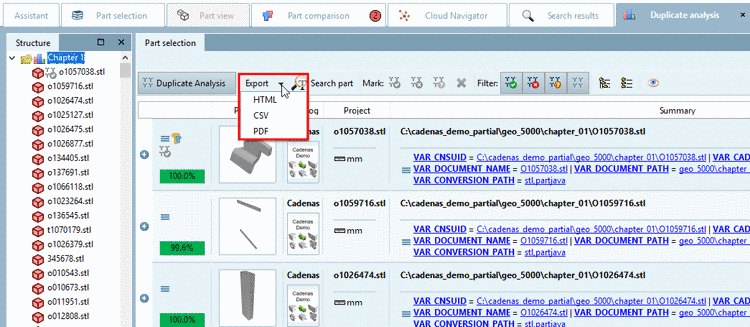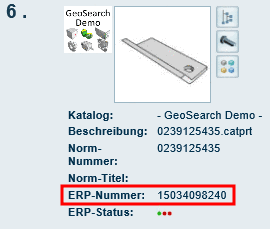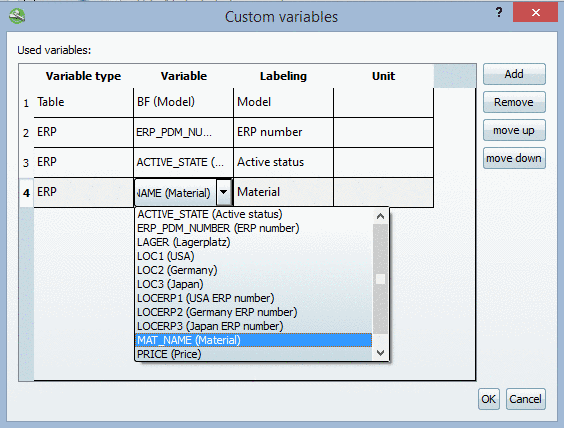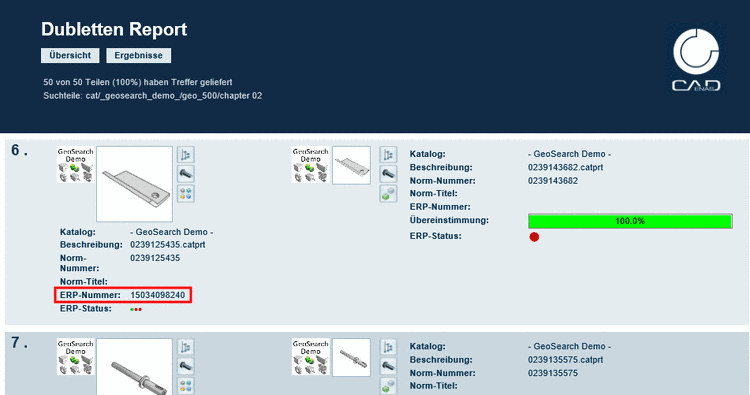Manual
Login
Our 3D CAD supplier models have been moved to 3Dfindit.com, the new visual search engine for 3D CAD, CAE & BIM models.
You can log in there with your existing account of this site.
The content remains free of charge.

Top Links
Manual
The results of analyses can be exported in HTML, CSV or PDF format.
-
HTML: You can export the analysis in HTML format.
-> The dialog box Export analysis results as HTML is opened.
-
Determine the variables Variables, whose value shall be displayed in the report.
When clicking on the button Edit custom variables
 , the dialog box Custom variables is opened.
, the dialog box Custom variables is opened.Here, you can specify variables which later will be displayed in the report additionally. They are shown at each part.
Both ERP variables and variables from the characteristic attribute table are possible.
At first click on in order to add a new line.
-
Via double-click into the line under Variable type the list field opens with the following options:
-
Via double-click into the line under "Variable" a list field with the following options opens:
-
Options at variable type "ERP":
When selecting "ERP" the ERP variables of the table are read and displayed in a list. You can also enter any other value.
-
Options at variable type "Table":
The characteristic attribute variables of the search directory (search source) are listed. You can also enter any other value.
-
-
Enter a labeling by clicking on it. This will be displayed in the report later.
-
Optionally you can state a unit.
If the variable has no own unit, the entered unit is displayed.
If the variable has a unit, the value is converted. (Currently conversion is only possible at the type "Variable".)
The diameter in the table is given in inches. You have stated mm as unit. -> The value is automatically converted from inches to mm.
-> The HTML export is performed.
In the stated directory, open index.html.
-
-
The Export CSV dialog box opens.
-
Fields: Under Fields, determine the Variables, whose values shall be included in the CSV file.
With a click on the button Edit custom variables
 the dialog box Custom variables is opened.
the dialog box Custom variables is opened.Here, you can specify variables which later will be displayed in the report additionally. They are shown at each part.
Possible are both ERP variables and variables from the characteristic attribute table.
At first click on in order to add a new line.
-
Via double-click into the line under Variable type the list field opens with the following options:
-
Via double-click into the line under "Variable" a list field with the following options opens:
-
Options at variable type "ERP":
When selecting "ERP" the ERP variables of the table are read and displayed in a list. You can also enter any other value.
-
Options at variable type "Table":
The characteristic attribute variables of the search directory (search source) are listed. You can also enter any other value.
-
-
Enter a labeling by clicking on it. This will be displayed in the report later.
-
Optionally you can state a unit.
If the variable has no own unit, the entered unit is displayed.
If the variable has a unit, the value is converted. (Currently conversion is only possible at the type "Variable".)
The diameter in the table is given in inches. You have stated mm as unit. -> The value is automatically converted from inches to mm.
-
-
Export only parts with the following states: This option is only relevant for Duplicate analysis. There the status can be marked. On this please see Section 3.1.15.2, “ Duplicate Analysis ”.
Export state: This option is only relevant for Duplicate analysis. There the status can be marked. On this please see Section 3.1.15.2, “ Duplicate Analysis ”.
Enable multithreading: Possibly makes sense in order to accelerate the process when using large files, if table variables shall be taken into the CSV. Especially in SSDs and network drives the activation should have a positive effect.
-
-
PDF: An Explorer window is opened. Determine the filename and click on . Special features like adding of variables are not provided here.





![[Note]](/community/externals/manuals/%24%7Bb2b:MANUALPATH/images/note.png)
![[Tip]](/community/externals/manuals/%24%7Bb2b:MANUALPATH/images/tip.png)




